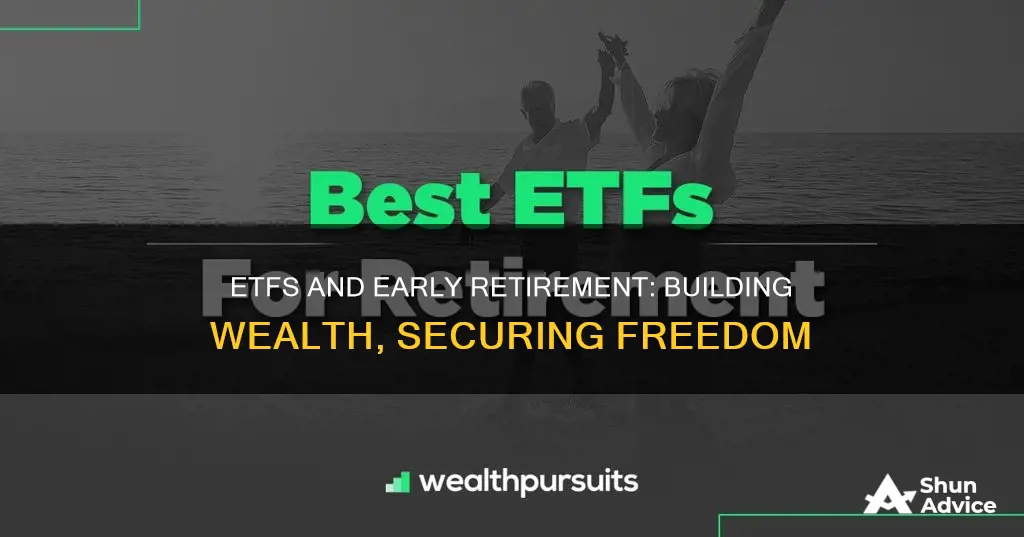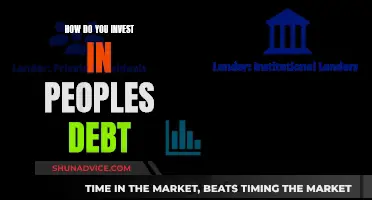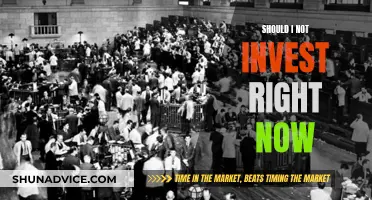
Exchange-traded funds (ETFs) are a popular investment vehicle for those seeking to retire early. The FIRE (Financial Independence, Retire Early) movement, which prioritises extreme saving and investing to achieve financial freedom, often favours ETFs for their low fees and diversification benefits.
ETFs are a type of investment fund that holds other assets, such as stocks or bonds, and they trade on an exchange like a stock, while also functioning like a mutual fund by pooling securities. They are a good option for retirees as they offer income generation, long-term growth potential, simplicity, diversification, low expenses, and tax efficiency.
While ETFs have pros and cons like any investment, they are a great foundational holding for long-term, buy-and-hold portfolios.
| Characteristics | Values |
|---|---|
| Definition | Exchange-traded funds that hold other investment assets, such as stocks or bonds |
| Retirement planning | A way to retire early and live a comfortable life |
| Investment options | Stocks, bonds, day trading, ETFs |
| ETF advantages | Diversification, low expenses, tax efficiency, income generation, long-term growth potential, simplicity |
| ETF disadvantages | Risk, lack of control |
| Types of ETFs | Dividend ETFs, fixed-income ETFs, sector ETFs, total market ETFs |
| Best ETFs | Vanguard S&P 500 ETF, Schwab U.S. Small-Cap ETF, iShares Core S&P Mid-Cap ETF, Invesco QQQ Trust, Vanguard High Dividend Yield ETF, Vanguard Total International Stock ETF, Vanguard Total World Stock ETF |
| FIRE movement | Financial Independence, Retire Early |
| FIRE savings | 50%-70% of income or more |
| FIRE rules | Rule of 25, 4% rule |
What You'll Learn
- ETFs are exchange-traded funds that hold other investment assets, such as stocks or bonds
- ETFs are a good investment for retirees due to their simplicity, diversification, low expenses and tax efficiency
- Dividend ETFs are income-based funds that invest in companies that pay high or stable and growing dividends
- Fixed-income ETFs, or bond ETFs, track an index of bonds and pay interest to shareholders
- ETF investors need to be aware of the risks and accept the bad eggs as well as the good

ETFs are exchange-traded funds that hold other investment assets, such as stocks or bonds
Exchange-traded funds, or ETFs, are a type of investment vehicle that holds other assets, such as stocks or bonds. They are similar to mutual funds in that they are pooled securities, but they trade intra-day on an exchange like stocks. ETFs are a good option for those looking to retire early as they are a diversified, low-cost, and tax-efficient investment option.
ETFs are a great option for those looking to build a diverse portfolio without spending a lot of time and money. By investing in an ETF, you get exposure to hundreds of stocks or other assets in one packaged security. This diversification helps to reduce risk and provides more stable returns than investing in individual stocks.
Additionally, ETFs have much lower expense ratios than mutual funds, which means higher returns in the long run. The low fees also ensure that more dividends and interest flow into retirement accounts, which is crucial for those living on a fixed income.
Another benefit of ETFs is their tax efficiency. They manage investment inflows and outflows by creating or redeeming "creation units", which increases tax efficiency. They also have low turnover, resulting in minimal buying and selling of securities, reducing capital gains taxes for retired investors with taxable accounts.
When it comes to retirement planning, ETFs can provide both short-term income generation and long-term growth potential. For example, bond ETFs provide interest income, while growth ETFs can help retirees' investments keep up with inflation.
While ETFs have many advantages, it's important to consider the potential drawbacks as well. ETFs are not risk-free, and even a diversified portfolio can produce negative returns, as seen during periods of high inflation and rising interest rates. Additionally, investors in individual securities have more control over the stocks and bonds they hold, whereas ETF investors are limited to the holdings of the fund.
Overall, ETFs are a great option for those looking to build a diverse, low-cost, and tax-efficient portfolio, making them a popular choice for those seeking to retire early.
Rent or Invest: The Great Property Dilemma
You may want to see also

ETFs are a good investment for retirees due to their simplicity, diversification, low expenses and tax efficiency
Exchange-traded funds (ETFs) are a good investment option for retirees due to their simplicity, diversification, low expenses, and tax efficiency.
ETFs offer a simple way to invest in a diversified portfolio of assets, providing exposure to various asset classes, sectors, and investment strategies. They are traded on stock exchanges, and their prices fluctuate throughout the day, making them easy to buy and sell.
One of the key advantages of ETFs is the level of diversification they offer. By investing in an ETF, individuals gain access to a basket of different assets, reducing the risk associated with investing in individual stocks. This diversification can stabilize the overall risk of a portfolio, as different asset classes respond differently to economic cycles. For example, combining stocks with high-quality investment-grade bonds can provide a cushion during economic downturns, as bonds often produce positive returns when stocks decline in value.
ETFs are also known for their low expenses. The expense ratio, which measures the cost of running the fund, is an important factor in determining the overall return for investors. ETFs typically have lower expense ratios compared to other investment options, such as mutual funds, resulting in lower costs of fund ownership.
Additionally, ETFs are considered tax-efficient. They are structured to minimize taxes for investors, resulting in lower tax liabilities than similar investments, such as mutual funds. ETFs have fewer "taxable events" because they create or redeem "creation units" instead of selling securities to accommodate investment inflows and outflows. This structure reduces the chances of investors being exposed to capital gains on individual securities within the fund.
Overall, ETFs are a good investment option for retirees due to their simplicity, broad diversification, low expenses, and tax efficiency. They provide an accessible way to create a well-rounded and resilient portfolio, making them a valuable tool for individuals seeking to grow and protect their retirement savings.
Retirement Reinvented: Navigating Post-Retirement Investment Strategies
You may want to see also

Dividend ETFs are income-based funds that invest in companies that pay high or stable and growing dividends
Dividend ETFs: Income-Based Funds for Retirement Planning
Dividend ETFs are a type of exchange-traded fund (ETF) that focuses on investing in companies that pay high or stable and growing dividends. These ETFs are designed to provide a reliable income stream for shareholders, offering an attractive option for those seeking to generate cash flow or stable returns.
ETFs are a hybrid investment vehicle, combining the features of stocks and mutual funds. They are traded on exchanges like stocks, offering liquidity and transparency, while also providing the diversification and low expenses typically associated with mutual funds. This makes ETFs a popular choice for retirees or those planning for retirement.
Dividend ETFs, in particular, offer several benefits:
- Income generation: Dividend ETFs invest in stocks that pay dividends, providing a steady income stream for shareholders. This is especially important for retirees who rely on their investments to supplement their income.
- Long-term growth potential: By investing in companies with stable and growing dividends, these ETFs offer the potential for long-term growth, helping retirees keep pace with inflation and ensuring their investments last throughout their retirement years.
- Diversification: Dividend ETFs provide exposure to a diverse range of dividend-paying stocks, reducing the risk associated with individual stocks. This diversification can lead to more stable returns over time.
- Low expenses: ETFs generally have lower expense ratios than mutual funds, resulting in higher returns over the long term. This is advantageous for retirees living on fixed incomes.
- Tax efficiency: The structure of ETFs allows for greater tax efficiency, minimizing capital gains taxes for investors with taxable accounts.
However, it's important to remember that dividend ETFs are not without risks. They are subject to market volatility, and there may be periods of negative returns. Additionally, investors have less control over the specific stocks held in the ETF compared to individual securities.
When considering dividend ETFs for retirement planning, it's crucial to assess your unique financial goals, risk tolerance, and time horizon. While dividend ETFs offer stable returns and income, they may not provide the same capital appreciation potential as growth-focused investments. Therefore, they are often suited to more conservative or income-focused investors.
Overall, dividend ETFs can be a valuable component of a retirement portfolio, offering diversification, income, and the potential for long-term growth. However, as with any investment, it's essential to understand the risks and conduct thorough research before investing.
AGNC Investment Dividends: Payout Patterns and Frequency
You may want to see also

Fixed-income ETFs, or bond ETFs, track an index of bonds and pay interest to shareholders
Exchange-traded funds (ETFs) are a type of investment vehicle that can be used as part of a strategy to retire early. The FIRE (Financial Independence, Retire Early) movement, for example, involves saving and investing 50% to 70% of your income through extreme frugality and diligent planning.
Fixed-income ETFs, or bond ETFs, are a type of ETF that tracks an index of bonds. They are passively managed and trade on major stock exchanges, such as the New York Stock Exchange (NYSE). Bond ETFs are similar to bond mutual funds in that they hold a portfolio of bonds with different strategies and holding periods. However, bond ETFs are more liquid and transparent than individual bonds or mutual funds, as they trade throughout the day on a centralized exchange.
Bond ETFs pay interest to shareholders in the form of monthly dividends, with the value of the coupon varying from month to month. They are a great option for gaining exposure to the bond market and are available for various bond categories, including Treasuries, corporates, convertibles, and floating-rate bonds.
Compared to mutual funds, bond ETFs have lower expense ratios, which generally leads to higher returns over time. They are also more tax-efficient, as they can manage investment inflows and outflows through the creation or redemption of "creation units". Additionally, bond ETFs have low turnover, minimizing capital gains taxes for retired investors with taxable accounts.
However, it is important to note that bond ETFs are not risk-free. They are subject to interest rate changes, which can negatively impact their performance. Additionally, there is a greater risk to an investor's initial investment in an ETF than in an individual bond, as there is no maturity date to guarantee the repayment of the principal in full.
The Great Debate: Mortgage Freedom or Investment Opportunities?
You may want to see also

ETF investors need to be aware of the risks and accept the bad eggs as well as the good
Exchange-traded funds (ETFs) are a popular investment vehicle for those seeking to retire early. The FIRE (Financial Independence, Retire Early) movement, for example, involves extreme saving and investment strategies to enable retirement far earlier than traditional plans. While ETFs offer diversification and low fees, they are not without risks.
ETFs are baskets of securities that track an underlying index, such as the S&P 500. They are a hybrid of stocks and mutual funds, offering the intra-day trading of stocks with the pooled securities of mutual funds. This means they can be traded like stocks, but they are also diversified like mutual funds, reducing risk.
However, investors need to be aware of the potential downsides. Firstly, while ETFs are generally considered tax-efficient, this advantage does not apply across the board. Actively managed ETFs, international ETFs, and those that use derivatives or invest in commodities can create unexpected tax bills. For example, international ETFs may not be able to do in-kind exchanges, leading to capital gains issues.
Secondly, the very nature of ETFs, being tied to an index, means they lack the active management of a mutual fund. This means an ETF will not sell a security if the issuer is in financial trouble unless it is removed from the index. This can lead to greater losses than a fund with an active manager who can take defensive positions.
Thirdly, the popularity of ETFs has led to a proliferation of niche offerings, which can increase the overall riskiness of a portfolio. For example, investing in a single country ETF adds political and liquidity risk. Leveraged ETFs amplify potential losses, and sector-specific ETFs tie your fortunes to the performance of one industry.
Additionally, the ability to trade ETFs like stocks can change an investor's mindset from long-term investor to active trader, increasing costs and the potential for losses through market timing.
Other risks include counterparty risk, where the performance of an ETF is tied to derivatives such as futures or options, and the risk of overlapping sector exposure within a portfolio, leading to a lack of diversification.
In summary, while ETFs offer many benefits, investors need to be aware of the potential pitfalls. Understanding these risks and planning accordingly will help investors make the most of the advantages of ETFs while minimising potential downsides.
The Great Debate: Paying Off Your Home vs. Investing — Which Should You Choose?
You may want to see also
Frequently asked questions
Exchange-Traded Funds (ETFs) are a type of investment vehicle that holds other investment assets, such as stocks or bonds. ETFs are traded on the share market and are similar to mutual funds as they are pooled securities. ETFs are a popular choice for those looking to retire early due to their low fees and diversification benefits.
The key advantages of ETFs include:
- Income generation: ETFs can provide supplemental income through dividends or interest payments, similar to stocks and bonds.
- Long-term growth potential: ETFs that track broad market indices have outperformed actively managed portfolios over long periods, reducing risk for retirees.
- Simplicity: ETFs are generally easier to manage than individual stocks and bonds, requiring less time and effort to build a diverse portfolio.
- Diversification: ETFs provide exposure to a wide range of stocks or assets, reducing risk by spreading investment across many firms.
- Low expenses: ETFs have lower expense ratios and fees compared to other investment options, resulting in higher long-term returns.
- Tax efficiency: ETFs are tax-efficient due to their ability to manage investment inflows and outflows, and they often invest in tax-free securities.
There are several ETFs that are commonly used for retirement planning, including:
- Dividend ETFs: These focus on investing in companies with high or stable dividends, providing regular income.
- Fixed-Income ETFs (Bond ETFs): These track an index of bonds and pay interest to shareholders.
- Sector ETFs: These invest in specific sectors or industries, such as technology, healthcare, real estate, or utilities.
- S&P 500 ETFs: These ETFs track the performance of the S&P 500 index, which includes 500 large US companies, and are often used as a core holding.
- Total Market ETFs: These track broad market indices, capturing large segments of the stock or bond market.







